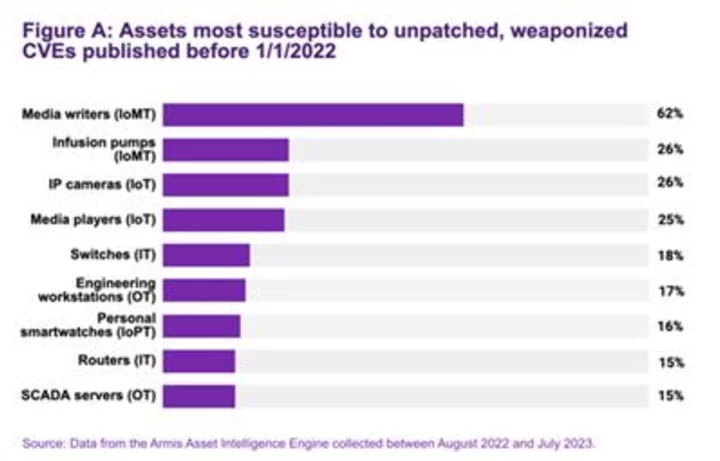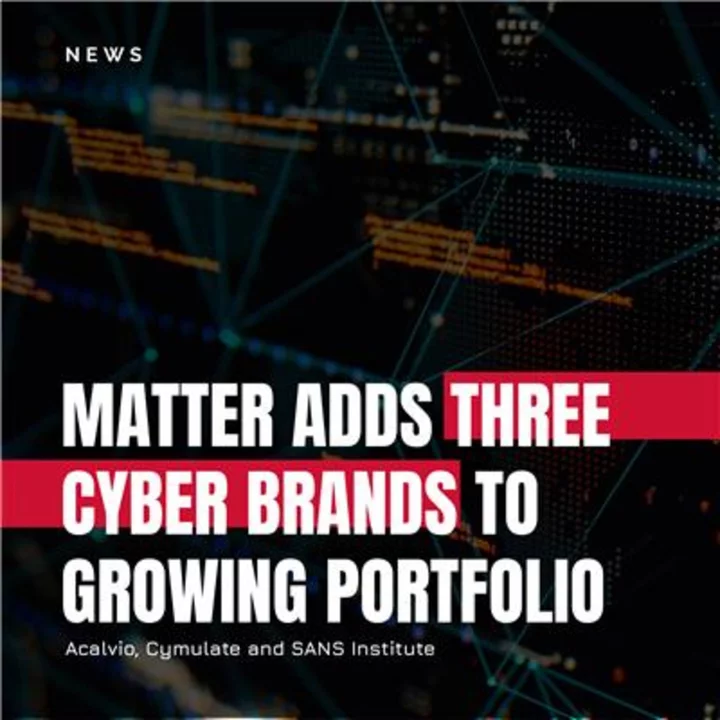SAN FRANCISCO--(BUSINESS WIRE)--Sep 5, 2023--
Armis, the leading asset visibility and security company, today released new research identifying the riskiest connected assets posing threats to global businesses. Findings highlight risk being introduced to organizations through a variety of connected assets across device classes, emphasizing a need for a comprehensive security strategy to protect an organization’s entire attack surface in real-time.
This press release features multimedia. View the full release here: https://www.businesswire.com/news/home/20230905844605/en/
Source: Data from the Armis Asset Intelligence Engine collected between August 2022 and July 2023.
“Continuing to educate global businesses about the evolving and increased risk being introduced to their attack surface through managed and unmanaged assets is a key mission of ours,” said Nadir Izrael, CTO and Co-Founder of Armis. “This intelligence is crucial to helping organizations defend against malicious cyberattacks. Without it, business, security and IT leaders are in the dark, vulnerable to blind spots that bad actors will seek to exploit.”
Armis’ research, analyzed from the Armis Asset Intelligence Engine, focuses on connected assets with the most attack attempts, weaponized Common Vulnerabilities and Exposures (CVEs) and high-risk ratings to determine the riskiest assets.
Assets With The Highest Number of Attack Attempts
Armis found the top 10 asset types with the highest number of attack attempts were distributed across asset types: IT, OT, IoT, IoMT, Internet of Personal Things (IoPT) and Building Management Systems (BMS). This demonstrates that attackers care more about their potential access to assets rather than the type, reinforcing the need for security teams to account for all physical and virtual assets as part of their security strategy.
Top 10 device types with the highest number of attack attempts:
- Engineering workstations (OT)
- Imaging workstations (IoMT)
- Media players (IoT)
- Personal computers (IT)
- Virtual machines (IT)
- Uninterruptible power supply (UPS) devices (BMS)
- Servers (IT)
- Media writers (IoMT)
- Tablets (IoPT)
- Mobile phones (IoPT)
“Malicious actors are intentionally targeting these assets because they are externally accessible, have an expansive and intricate attack surface and known weaponized CVEs,” said Tom Gol, CTO of Research at Armis. “The potential impact of breaching these assets on businesses and their customers is also a critical factor when it comes to why these have the highest number of attack attempts. Engineering workstations can be connected to all controllers in a factory, imaging workstations will collect private patient data from hospitals and UPSs can serve as an access point to critical infrastructure entities, making all of these attractive targets for malicious actors with varying agendas, like deploying ransomware or causing destruction to society in the case of nation-state attacks. IT leaders need to prioritize asset intelligence cybersecurity and apply patches to mitigate this risk.”
Assets With Unpatched, Weaponized CVEs Vulnerable to Exploitation
Researchers identified a significant number of network-connected assets susceptible to unpatched, weaponized CVEs published before 1/1/2022. Zooming in on the highest percentage of devices of each type that had these CVEs between August 2022 and July 2023, Armis identified the list reflected in Figure A. Unpatched, these assets introduce significant risk to businesses.
Assets with a High-Risk Rating
Armis also examined asset types with the most common high-risk factors:
- Many physical devices on the list that take a long time to replace, such as servers and Programmable Logic Controllers (PLCs), run end-of-life (EOL) or end-of-support (EOS) operating systems. EOL assets are nearing the end of functional life but are still in use, while EOS assets are no longer actively supported or patched for vulnerabilities and security issues by the manufacturer.
- Some assets, including personal computers, demonstrated SMBv1 usage. SMBv1 is a legacy, unencrypted and complicated protocol with vulnerabilities that have been targeted in the infamous Wannacry and NotPetya attacks. Security experts have advised organizations to stop using it completely. Armis found that 74% of organizations today still have at least one asset in their network vulnerable to EternalBlue – an SMBv1 vulnerability.
- Many assets identified in the list exhibited high vulnerability scores, have had threats detected, have been flagged for unencrypted traffic or still have the CDPwn vulnerabilities impacting network infrastructure and VoIPs.
- Half (50%) of pneumatic tube systems were found to have an unsafe software update mechanism.
Additional research from Armis is available on the riskiest OT and ICS devices across critical infrastructure industries as well as the riskiest medical and IoT devices in clinical environments.
Learn more about Armis at www.armis.com.
About Armis
Armis, the leading asset visibility and security company, provides the industry’s first unified asset intelligence platform designed to address the new extended attack surface that connected assets create. Fortune 100 companies trust our real-time and continuous protection to see with full context all managed, unmanaged assets across IT, cloud, IoT devices, medical devices (IoMT), operational technology (OT), industrial control systems (ICS), and 5G. Armis provides passive cyber asset management, risk management, and automated enforcement. Armis is a privately held company and headquartered in California.
View source version on businesswire.com:https://www.businesswire.com/news/home/20230905844605/en/
CONTACT: Rebecca Cradick
Senior Director, Global Communications
Armis
pr@armis.com
KEYWORD: UNITED STATES NORTH AMERICA CALIFORNIA
INDUSTRY KEYWORD: DATA MANAGEMENT SECURITY TECHNOLOGY OTHER TECHNOLOGY SOFTWARE NETWORKS INTERNET
SOURCE: Armis
Copyright Business Wire 2023.
PUB: 09/05/2023 09:00 AM/DISC: 09/05/2023 09:03 AM
http://www.businesswire.com/news/home/20230905844605/en









